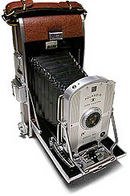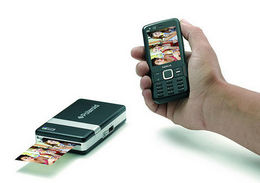Difference between revisions of "Polaroid Camera"
(→Death) |
(→Future) |
||
| Line 36: | Line 36: | ||
| − | In June 2008 the Polaroid Corporation partnered with Zink to create the Polaroid PoGo Instant Mobile Printer. | + | In June 2008 the Polaroid Corporation partnered with Zink to create the Polaroid PoGo Instant Mobile Printer - a small, portable, battery-powered printer from the company that was built on Edwin Land's Polaroid (New York Times). |
<blockquote> “Polaroid PoGo™ - short for Polaroid-on-the-go - is a pocket-sized, ink-free digital photo printer that produces full-color photos wirelessly from Bluetooth-enabled cell phones and via PictBridge from digital cameras. Weighing only eight ounces, Polaroid PoGo™ provides consumers with a convenient solution for sharing digital images trapped on cell phones and digital cameras. Connecting via Bluetooth or PictBridge, Polaroid PoGo™ uses a revolutionary ZINK Zero Ink Zero Hassles™ Printing Technology to produce borderless,full-color, 2-inch by 3-inch prints in less than 60 seconds” (Zink). <Blockquote> | <blockquote> “Polaroid PoGo™ - short for Polaroid-on-the-go - is a pocket-sized, ink-free digital photo printer that produces full-color photos wirelessly from Bluetooth-enabled cell phones and via PictBridge from digital cameras. Weighing only eight ounces, Polaroid PoGo™ provides consumers with a convenient solution for sharing digital images trapped on cell phones and digital cameras. Connecting via Bluetooth or PictBridge, Polaroid PoGo™ uses a revolutionary ZINK Zero Ink Zero Hassles™ Printing Technology to produce borderless,full-color, 2-inch by 3-inch prints in less than 60 seconds” (Zink). <Blockquote> | ||
| Line 45: | Line 45: | ||
---- | ---- | ||
| + | |||
=Works Cited= | =Works Cited= | ||
---- | ---- | ||
Revision as of 15:07, 25 October 2008
Dr. Edwin Land (a physicist) came to the forefront of photographic technology in 1929 when he created the first synthetic sheet polarizer; thus solving "one of science’s long-standing 'unsolvable' problems – polarizing light without needing a large crystal of an esoteric mineral" (Save Polaroid). Then, in 1937 Dr. Land founded the Polaroid Corporation. However, the idea of an instant camera (and subsequently instant photography) wasn’t envisioned by Dr. Land until 1943 in response to his 3-year-old daughter’s confusion as to why a camera could not instantly produce pictures – “Why can’t I see them now?” (New York Times).
Dr. Land was responsible for overseeing the development of products for the Polaroid Corporation – including the first instant camera. In 1947 the concept of instant photography was presented to The Optical Society in New York City and shortly after, in 1948, Polaroid 95 Instant photography became available to the public with the Polaroid Model 95 camera (also referred to as the Polaroid Land Camera) and Type 40 film. The Polaroid Land Camera was welcomed and widely accepted by consumer markets – even with a $95 price-tag (approximately $850 today) the cameras flew off shelves and sold out in a matter of weeks. The demand for the new camera was so great that backorders began being taken and consumers started to pay up to $150 (approximately $1350 today) for the new instant photography device (Save Polaroid).
A long line of instant photography developments and products proceeded the Polaroid Land Camera’s release and by the 1960’s approximately fifty-percent of American households owned a Polaroid camera (New York Times).
Contents
How it Works
Uses
Different Models
Public Reception
Controversy and Lawsuit
Fall
Death
It’s ironic that the death of the Polaroid (“Instant”) Camera resulted from the device’s inability to be “instant” enough. “But in a day when nearly every cellphone has a digital camera in it, ‘instant’ photography long ago stopped being instant enough for most people” (New York Times).
The Polaroid Company, which ceased their production of instant cameras for consumers a in 2007 and for commercial use in 2006, announced this year (2008) that it will also cease to produce and manufacture instant film come 2009.
However, the Polaroid Company is allowing their technology to be licensed to other manufacturers after 2009 – should they want to provide the film to the niche market that will continue to use the Polaroid Camera (New York Times). Furthermore, there has been confirmation that at least three of the peel-apart pack films will be reintroduced in 2009 (Zink).
Future
In June 2008 the Polaroid Corporation partnered with Zink to create the Polaroid PoGo Instant Mobile Printer - a small, portable, battery-powered printer from the company that was built on Edwin Land's Polaroid (New York Times).
“Polaroid PoGo™ - short for Polaroid-on-the-go - is a pocket-sized, ink-free digital photo printer that produces full-color photos wirelessly from Bluetooth-enabled cell phones and via PictBridge from digital cameras. Weighing only eight ounces, Polaroid PoGo™ provides consumers with a convenient solution for sharing digital images trapped on cell phones and digital cameras. Connecting via Bluetooth or PictBridge, Polaroid PoGo™ uses a revolutionary ZINK Zero Ink Zero Hassles™ Printing Technology to produce borderless,full-color, 2-inch by 3-inch prints in less than 60 seconds” (Zink).
Works Cited


